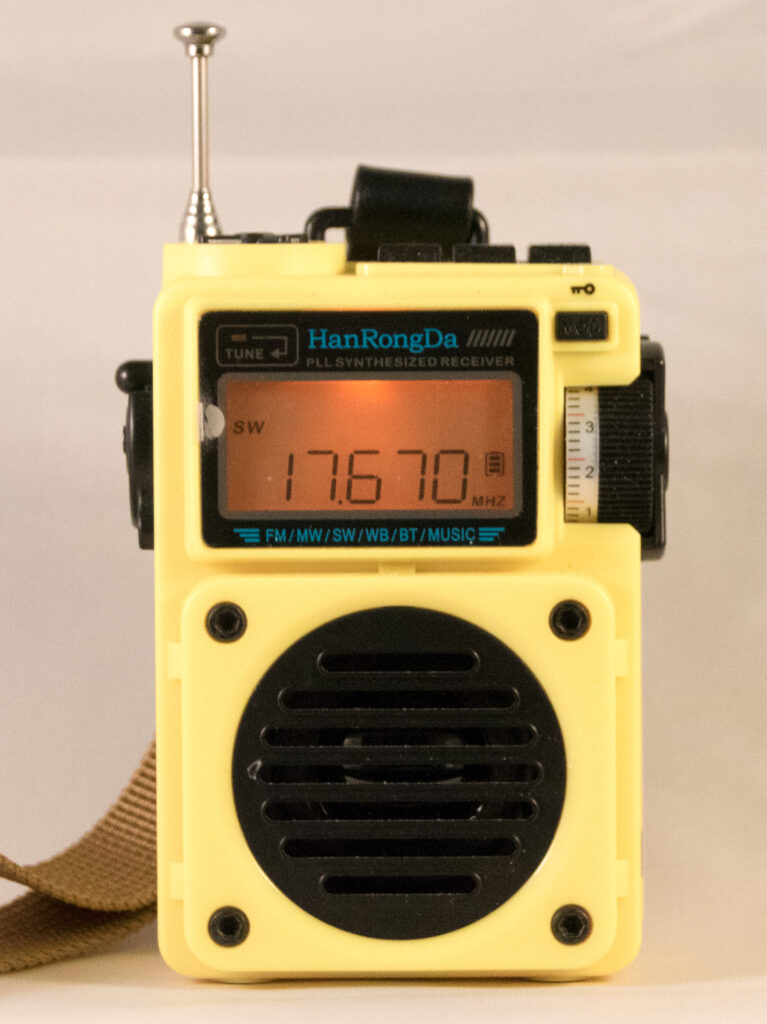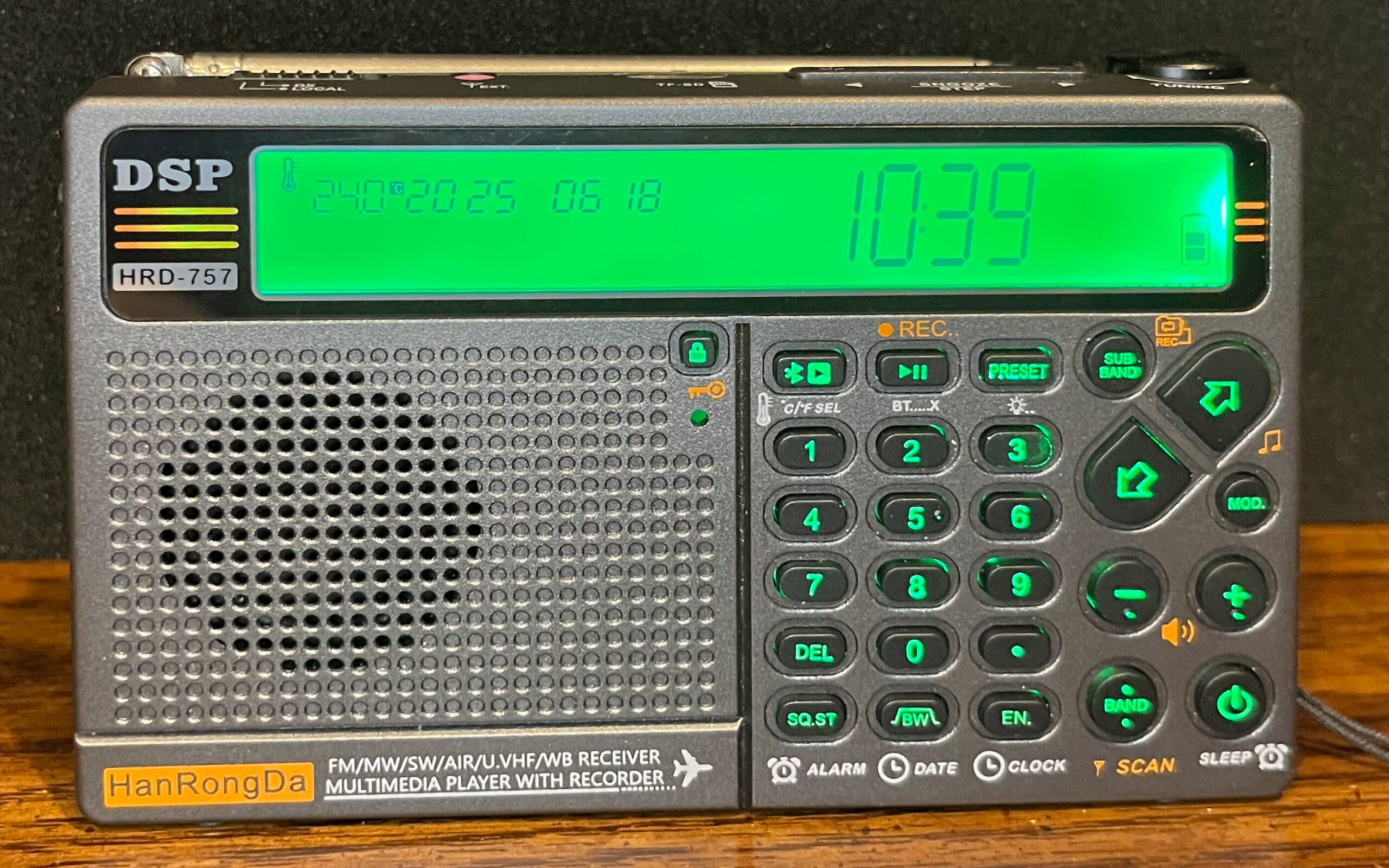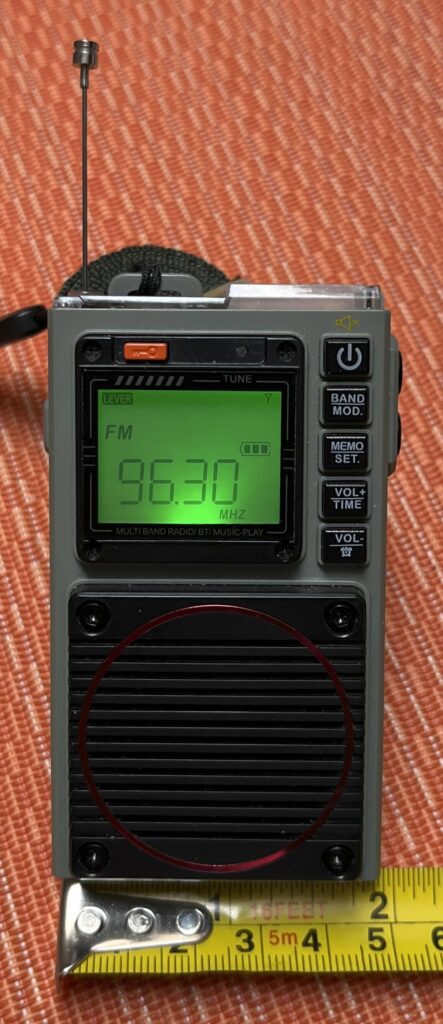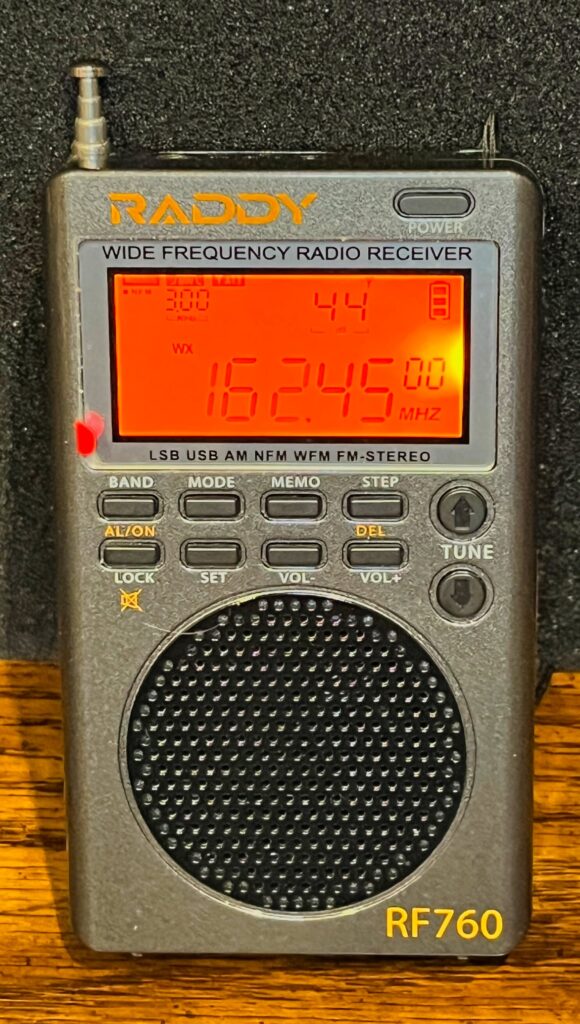It’s hard to believe that it’s been over a year since my article, The Thunderous Clash of the Weather Radios, but in that time quite a bit weather radio wise has happened. The iRonsnow IR-688 and the Mesqool CR1009 Pro are gone (donated to charity) and somehow the remaining 6 weather radios in my accumulation has exploded in number to 15!
Today Fluvanna County, Virginia, where I live is under an Extreme Heat Advisory, prompting me to get the official NOAA forecast via radio from weather station KZZ28. The station is located on Mount Olive 37°52’35.8″N 78°41’27.6″W, 21 miles from where I live. Here’s the satellite imagery:
Also shown is the Fan Mountain Observatory. I thought about driving up for a photo op, but I’m informed that the road is closed to general traffic with the exception of twice a year when the public is invited to the observatory.
On a good day, I can receive three weather stations: my local station KZZ28 on 162.450 MHz, WXK65 on 162.475 in Richmond, VA, and WXL21 on 162.550 in Lynchburg. More about the “good day” later.
Update: I found a cool website with information about NOAA weather stations, WeatherRadio.NET.
The Radios
Too many for a group photo on my radio desk, the radios took turns (click photos to expand).
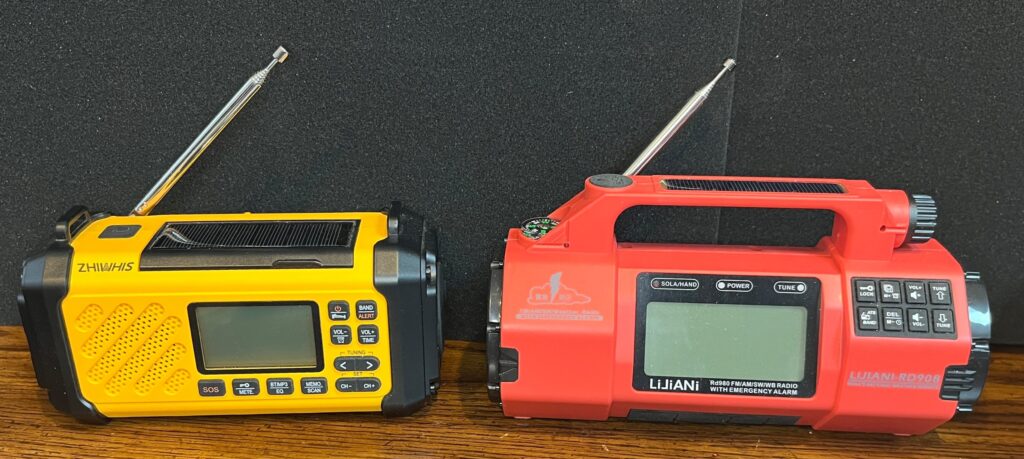



What we have is a mixture of emergency radios, walkie talkies, SDRs and shortwave radios that include weather band. Most have an alert feature but some do not.
Here is a table listing each of them, with links to articles that mention them, along with just a few features.
| Radio | Alerts | Flashlight | Charges Other Devices | Thermometer | Battery |
|---|---|---|---|---|---|
| Baofeng GM-15PRO | Y | BL-13UV | |||
| HanRongDa HRD-701 | Y | BL-5C | |||
| HanRongDa HRD-757 | Y | Y | Y | 18650 | |
| HanRongDa HRD-908 | Y | Y | Y | 2 x 18650 | |
| Jazmm 213 | Internal | ||||
| LiJiANi Rd239 | Y | Y | BL-5C | ||
| LiJiANi Rd908 | Y | Y | Y | 2 x 18650 | |
| Mesqool CR1015 | Y | 3 AAA | |||
| Raddy RF75A | Y | Y | Internal | ||
| Raddy RF760 | Y | Y | BL-5C | ||
| RTL-SDR Blog V3 | n/a | ||||
| RTL-SDR Blog V4 | n/a | ||||
| XHDATA D-109WB | Y | Y | 18650 | ||
| XHDATA D-608WB | Y | Y | Y | Y | 18650 |
| XHDATA E-100 | Y | BC-K626 | |||
| Zhiwhis ZWS-2415 | Y | Y | Y | 10000 mAh |
Technical Difficulties
At this point I’m ready to look at individual radios and there will likely be some pictures. That proved a problem with the RTL-SDR Blog V4 SDR. Apparently SDR software doesn’t play nice with AMD processors like the one on my new (ish) Microsoft Surface 11 Pro tablet. So that took up most of the afternoon, but is now resolved. See: Running SDR++ on an ARM Processor Under Windows 11.
We now return you to your regularly scheduled programming.
The Contenders
I’ve written quite bit about most of these radios, and so I’m linking to the other articles for the heavy lifting.
Baofeng GM-15PRO
The Baofeng GM-15PRO is primarily a walkie talkie, but since they have circuitry that handles the frequencies, why not up the user interface to receive weather?

The little cloud icon upper right on the keyboard puts the unit in weather mode, and the user can use the up and down arrows to change scan to the next active channel. This model has 4 more channels than US NOAA frequencies. The manual says the extras are Canadian.
The receiver is quite good with the short antenna, and receives my 3 NOAA stations clearly. Which ones? There’s the rub. The stations are listed only by number, not frequency. I get 1, 3 and 5. Here are the frequencies from the manual:

It doesn’t listen for weather alerts. All in all, if you’re out camping or boating with one of these radios, catching a weather broadcast could be a lifesaver. The flashlight is cool too. The battery is 1500 mAh.
HanRongDa HRD-701
I’ve had the HanRongDa HRD-701 for several years. It’s tiny, but with a powerful speaker and a nifty set of features. It handles weather alerts, just hold down the >|| key when on the weather band. Long press again to exit alert mode. I actually received 4 different weather stations on this one.
HanRongDa HRD-757
The HanRongDa HRD-757 is a feature rich radio that includes weather alerts. With some careful positioning, it could receive 3 NOAA stations indoors, but not as easily as the HRD-701 and some some of the others. It has a flashlight and weather alerts. Long press the BAND button to enter Alert mode. All the keys (except BAND) are disabled in this mode, so you can’t turn flashlight on or off.
It also has a thermometer, in a no-mans land between off and on, where it displays time and temperature. The temperature is always in Centigrade until you explicitly change it, returning to Centigrade again on the next power on.
Jazmm 213
The Jazmm 213 is my newest weather radio. It has weather alerts and a flashlight. It’s main claim to fame is a powerful speaker and compact size, making it an option for a go bag or camping.
It was one of the weakest contenders, receiving one station clearly and a second with lower quality.
LiJiANi Rd239
The LiJiANi Rd239 is sometimes overlooked, but it is a very sensitive receiver with a very bright flashlight plus a reading light. It also has lighted keys.
It received 3 weather stations clearly and a 4th weakly. Scanning for weather alerts is accomplished with a long press of the SCAN button.

LiJiANi Rd08
The LiJiANi Rd908 is one of the three “emergency radios” in this collection. By that I mean that it can charge other devices, and can itself be charged with solar power or a crank. They all have an SOS siren.

This one scans for alerts, started by long pressing the ATS key when set to weather band. It will display “ALE” while scanning.
It has interesting battery options: two 18650 batteries, three AA batteries or one 14500 battery. The AA batteries are not charged in the radio, but the others are.
There was an issue with this radio not being the latest version, and concerns from the seller about tariffs. Since that time, there has been a price increase (from $35.90 to $59.90), and Amazon no longer offers the red version pictured above. Instead there is a new green version under the HanRongDa brand. According to the Amazon product listing: “The green version HRD908 has Bluetooth and TF card playback functions. The orange and red versions are RD908 [do] not have these two functions.” The green one also offers VHF reception (30-200 MHz), but reduced shortwave coverage, 4.75-21.8 MHz:

I ordered a green one. (A Zhiwhis branded version is available for a lower price.)
Mesqool CR1015
The Mesqool CR1015 was an afterthought, provided by Amazon for almost nothing when bundled with the Mesqool CR1019Pro. It’s a very simple radio, powered by 3 AAA batteries. It has no convenient tuning mode, which is why it stays on the shelf in my house. The user has to hold down a button that scans the entire ban slowly, and doesn’t speed up if the button is held.
It received 2 weather stations clearly and the 3rd fair.
Raddy RF75A
The Raddy RF75A is notable for its mobile phone app control, and a good speaker. It also has a flashlight
Richmond, we have a problem. Writing this article spanned multiple days and today I’m not receiving the more distant weather stations on the radios that got them yesterday. I thought that the VHF weather band used line of sight transmission. Until I get this worked out, the radios tested today will not have the number of stations received listed. 🙁
Update: I waited until there was a better day, and completed the testing.
It might be that yesterday we had extraordinary conditions. Normally VHF transmissions are not affected by time of day or reflections from atmospheric layers; however, there are conditions such as tropospheric ducting where VHF signals are internally reflected by the atmosphere and may travel far beyond their normal path. The interested reader might want to take a look at the Tropospheric Ducting Forecast.
Number of weather stations received: 3, but two were weak.
Raddy RF760
The Raddy RF760 is amazing in how many features are crammed in such a tiny package, including VHF, UHF, SSB, AIR band and weather band — no flashlight, though.
Number of weather stations received: 3, but two were weak.
RTL-SDR Blog V3 and V4 and SDR++
I rarely use my V3 RTL-SDR Blog dongle, so will just mention it and continue with V4. V4 is really much nicer.
Here’s the screenshot of SDR++ displaying the NOAA weather station KZZ28, with traces from two other. I set the rabbit ears for 18.5″ to accommodate the 162.450 MHz frequency. With setup, there are three solid weather stations to choose from.
XHDATA D-109WB
The XHDATA D-109WB is a nice variant of the D-109, adding weather alerts and a Local/DX switch. It has no flashlight, but it does display temperature (when off), plays music files, acts as a Bluetooth speaker. It’s a good performer overall except for its tendency to overload in strong signal areas. It works well for me, but has problems in nearby Charlottesville.
I have problems with XHDATA radios and weather alerts. My local station has a super faint tone underlying the broadcast on occasion, and it causes this radio and the D-608 to sound the alarm, multiple times a day. I haven’t tried it lately, since the tone cleared up.
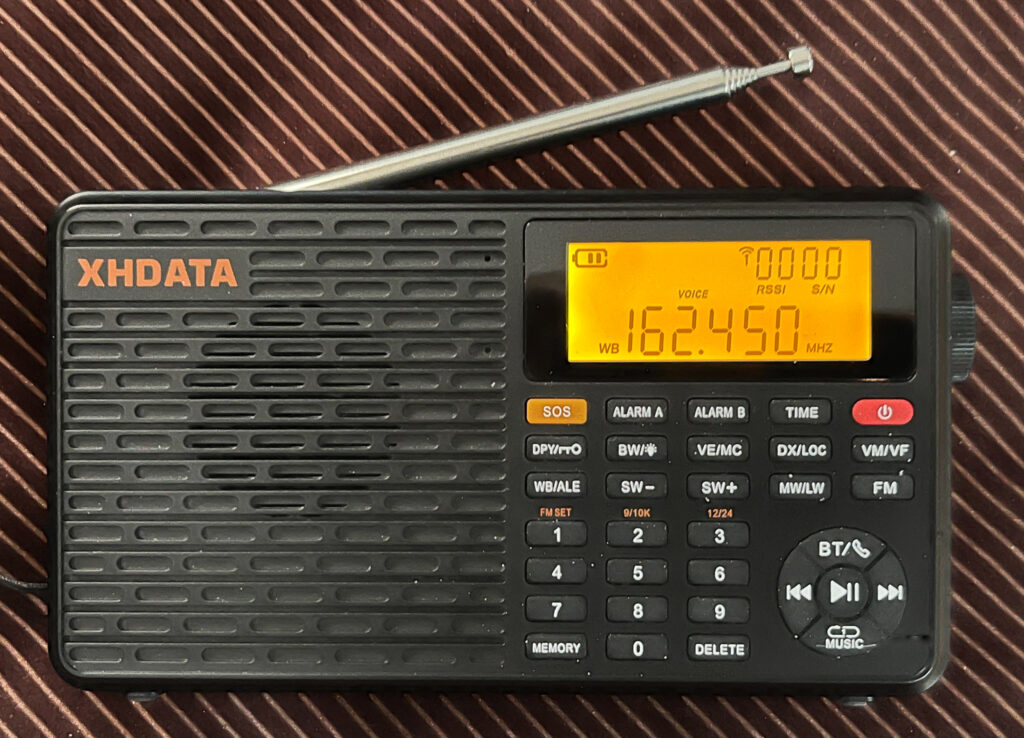
Number of weather stations received: 3, but two were weak.
XHDATA D-608WB
Disclosure: XHDATA sent me this radio as an evaluation copy. It may differ from the final released version.
The XHDATA D-608WB is smaller than the other emergency radios and is powered by just one 18650 battery. It can nevertheless charge other devices via USB and act as a Bluetooth speaker. When the radio is off, it displays the temperature.
While it has the lowest battery capacity of the emergency radios, it also has the advantage of simplified battery replacement.
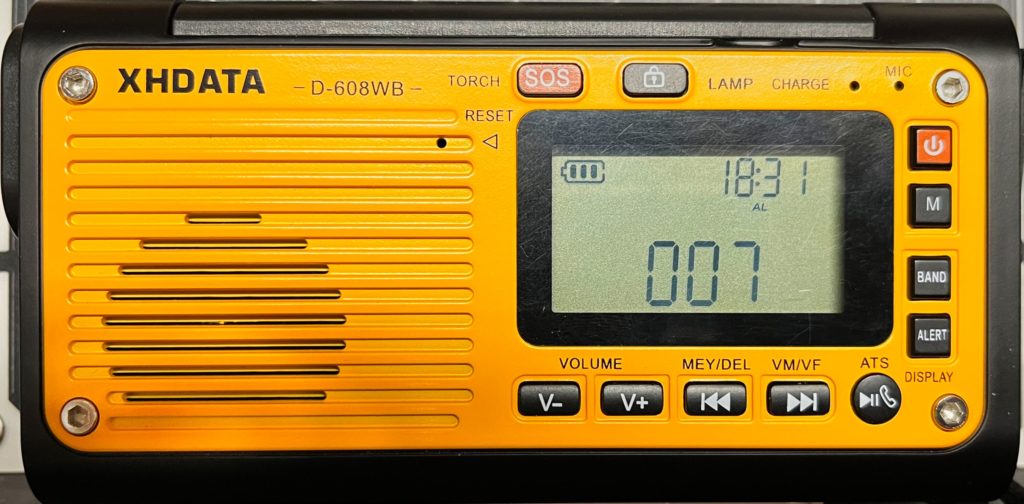
My review copy has poor FM performance but I don’t think this is a general problem.
Number of weather stations received: 1. This might be tied to the FM issue, the radio is just not very good in the upper frequencies.
XHDATA E-100
Disclosure: XHDATA sent me this radio as an evaluation copy. It may differ from the final released version.
The XHDATA E-100 appears to be a repackaged Baofeng K6 Tri-Mode ham radio walkie talkie. It covers GMRS frequencies, but it is not legal for use on this band. The manual says:
You may be tempted to use PMR446 (in Europe) or FRS, GMRS, MURS (in the USA) frequencies. Do note however that there are restrictions on these bands that make this transceiver illegal for use.
It operates very much like the Baofeng GM-15PRO as far as weather operation is concerned. It receives the same US/Canadian frequencies. One annoyance the two radios share is the inability to actually tune a station. The radio scans for the next station, and often skips over one. It seemed to receive all three weather stations in my region.
It has a 3000 mAh battery. The weather function is accessed through a long press of the “0” key.
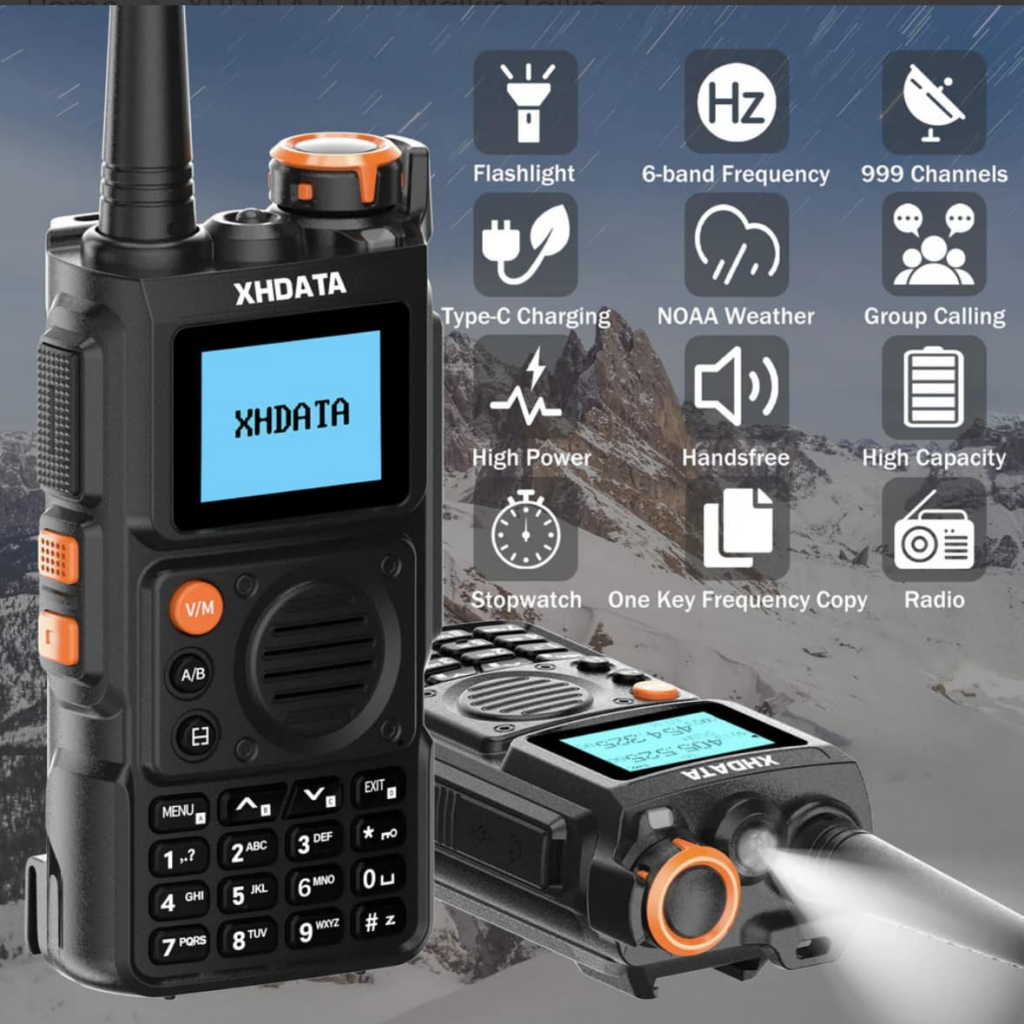
Number of weather stations received: 3, but two were weak.
Zhiwhis ZWS-2415
The Zhiwhis ZWS-2415 is currently my daily driver for weather. Frankly, one reason I keep it bedside is because that little black button on the top turns on the display light for a short time and displays the clock. The radio is very stable and won’t easily roll over. It’s also the largest battery capacity of the group with 10000 mAh.
But beyond that, it is a very good radio, and the only one of the emergency weather radios to receive VHF in addition to MW/FM/SW and weather. It gets two weather stations clearly plus the third after careful positioning.
FM performance matches my best FM radios. It also has VHF: 30.00-199.975MHz.
It has all the emergency bells and whistles except a compass, and it can act as a Bluetooth speaker.
It is a flexible external speaker with Bluetooth, AUX, MP3 via flash drive and MP3 via MicroSD card.
It also has a feature that I don’t usually pay attention to on emergency radios or radios in the weather context: a signal strength indicator. It’s a bar at the top of the display. When comparing daily reception or antennas, this is useful.

Number of weather stations received: 3, but two were weak.
Incoming Radio
I have a HanRongDa HRD908 arriving tomorrow. It looks just like a green version of the LiJiANi Rd908, but with added features like Bluetooth and MP3 play, along with VHF coverage.
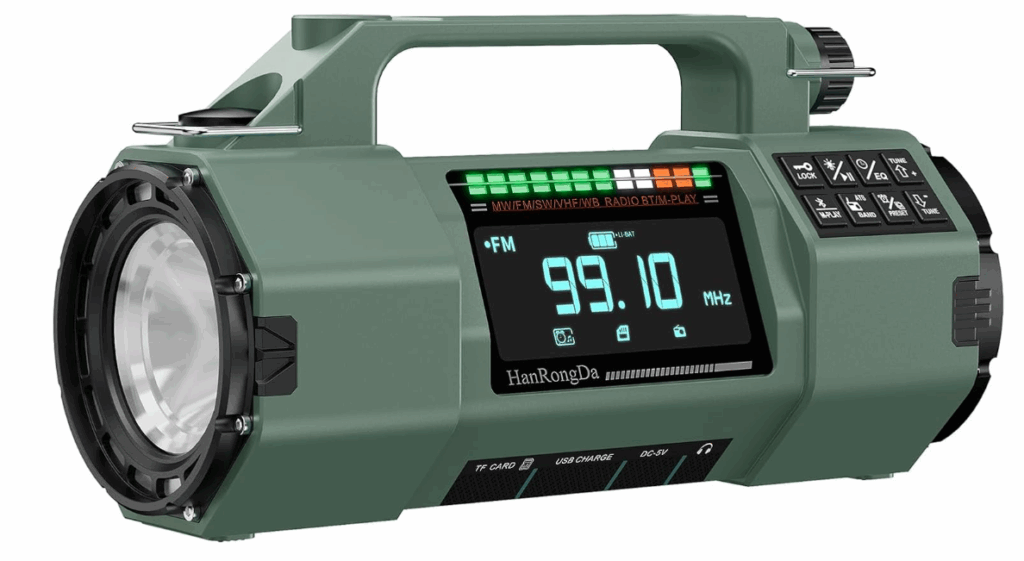
It turns out that this is a very different radio from the Rd908. Its exciting feature, undisclosed by Amazon, is app control, by the same Radio-C/Radio-CT app used by the Raddy RF75A and the HRD-757.
It receives 3 weather stations clearly. It’s definitely a contender for my daily driver.
Rogues Gallery
I figure that if a radio works, but I don’t like it, someone else might get something out of it, and I donate it to charity. This is especially true of weather radios that might be of use in an emergency. I donated an iRonsnow IR-688, Mesqool CR1009 Pro, Axyebi MD-107, Sttfaishen S10 and a Raddy RF866.


